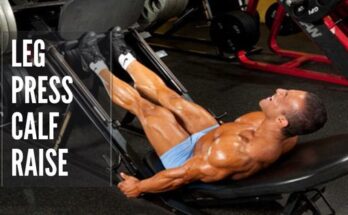You must be curious what’s the difference between compound vs isolation exercises? or are compound exercises better than isolation exercises?
Well, in this article we’ll clear all your queries regarding compound and isolation exercises So let’s dive deep into it.
What Are Compound Exercises?
Compound exercises are the exercises in which multiple muscles and joints work together. For example squats, deadlifts, bench press, etc.
Resistance training comprises mainly two types of exercises: compound exercises and isolation exercises.
A compound exercise is simply that which utilizes multiple muscle groups and joints at the same time. For instance, squats mainly target quadriceps but also hit hamstrings, calves, glutes, and core muscles.
Here are some examples of major compound exercises:
- Squats,
- Dead-lifts,
- Bench press,
- Barbell overhead press,
- Barbell bent-over rows, etc
Related article: Compound Exercises: Benefits, Types, & Safety Tips.
What are Isolation Exercises?
Isolation exercises are the exercises that target a specific muscle and involves a single joint. For example bicep curl.
As the name suggests, isolation exercises are those exercises that are done to isolate a particular muscle group. Unlike compound movements, isolation exercises focus on a single muscle and joint at a time.
Extensions, curls, and raises usually come under the category of isolation exercises. Some examples of isolation exercises are:
- Concentration curls,
- Leg extensions,
- Cable chest flyes,
- Dumbbell lateral raise,
- Hamstring curls,
- Cable pushdown, etc
Now let’s have a look in detail at compound exercises vs isolation exercises.
Compound Exercises vs Isolation Exercises
A proper workout routine comprises both types of movements. Both have their own place and different benefits.
| Compound Exercises | Isolation Exercises |
|---|---|
| Includes multiple muscles and joints | Focus on an individual muscle |
| Helps in the overall development of the body | Increases strength of a specific muscle |
| Time efficient | Takes more time to train full body |
| Elevates heart rate and burns more calories | Comparatively less fatigue |
| Requires fewer pieces of equipment | Requires fancy gym machines |
Benefits of Compound Exercises
These exercises simulate real-world activities and are at the heart of any fitness program. Your workout is incomplete without them as they give you several major benefits over the isolated ones.
Builds more strength and power
If you want to increase your muscular strength and power then it is essential to lift heavy.
As compound movements utilize multiple muscle groups and joints simultaneously, it gives you the luxury to lift super heavyweight. And hence, compound movements become very beneficial when your primary goal is to build strength and power.
One thing to remember is the form – make sure you are lifting with the correct form and technique. As there are more chances of injuries while lifting heavy.
Better muscle-building benefits
Compound exercises give better muscle-building benefits than isolation exercises. It utilizes more muscles during the exercises.
Heavy compound lifts also boost testosterone production which further helps in building muscles.
Along with that, compound movements strengthen your stabilizing muscles and improves overall body balance.
Provides cardiovascular benefits
Compound lifts are more challenging and require more energy. Due to this, it keeps your heart rate up and improves your cardiovascular ability as well.
Burn more calories
As you know that compound exercises involve multiple muscles and joints. This enables you to lift heavy weights and eventually you burn more calories.
This is why it is always recommended to add compound exercises to your workout routine during fat loss.
Better inter-muscular coordination
While performing compound movement, you require multiple muscle groups to complete the lift. Like while doing squats, you move your hips in all planes and includes different muscles of the legs and core.
This improves inter-muscular coordination and works on the overall development of the body.
Isolation Exercise Benefits
Though compound exercises are the major ones, isolation exercises are also important as they have different benefits. Here are the benefits of isolation exercises:
Allows you to strengthen weaker muscles
Sometimes we unknowingly neglect a particular muscle. For example rear deltoids, usually beginners don’t train that muscle properly and end up with weaker rear delts.
In that scenario, isolation exercises help a lot as we can do more focus on that muscle to make it stronger.
Helps during injury recovery
During the recovery from an injury isolation exercises are ideal. As they help you in strengthen a particular muscle.
Helps in removing muscle imbalance
In the long run, when you’ll build up a decent muscle mass, you may have the problem of the muscle imbalance in some areas. In that case, isolation exercises would be very effective to get a symmetric physique.
For instance, if you have an asymmetric chest, you can do a single arm dumbbell bench press to do more focus on the weaker side of your chest.
Targeting a specific muscle
For a complete functional workout, compound exercises are good enough. But when you want to work on a specific muscle or joint, then isolation exercises are ideal.
Creating A Workout Routine
A well-designed workout plan should contain both types of exercises as they both have their own benefits. If you have a personal trainer, then it’s good. If not, then consider these tips to create your own workout plan accommodating both compound and isolation exercises.
1. Include 2-3 compound exercises and 2-3 isolation exercises in your workout regime.
2. Start your workout with a compound exercise as you’ll have the maximum muscle glycogen in the beginning so use it in your main lifts. And do the isolation exercises later.
3. Don’t miss out on the major compound lifts like squats and deadlifts, especially if you are a beginner. These exercises help in building core strength and overall development of your body.
Here is an example of a back workout for reference.
| 1. Barbell bent-over rows | 4 sets x 8-10 reps |
| 2. Deadlifts | 4 sets x 6-8 reps |
| 3. Lat pull-down | 3 sets x 10-12 reps |
| 4. One-arm dumbbell rows | 3 sets x 12 reps |
| 5. Back extensions | 3 sets x 15-20 reps |
Make sure that you don’t need to copy the exact workout. You can change the number of sets and reps as per your fitness level and training experience.
Compound vs Isolation Exercises: SUMMARY
So this was a detailed and research-based analysis of compound vs isolation exercises.
Both have their place in a well-prepared fitness program. So add both types of exercises and prepare your workout plan wisely to get maximum benefits from your training.
References:
1. Single vs. Multi-Joint Resistance Exercises: Effects on Muscle Strength and Hypertrophy – Asian Journal of Sports Medicine.
2. Progression Models in Resistance Training for Healthy Adults – Medicine & Science in Sports & Exercise.
Thank you for reading this so far. I hope you liked this article and learned something valuable from this.
If you have any queries regarding compound movements, feel free to ask in the comments.



